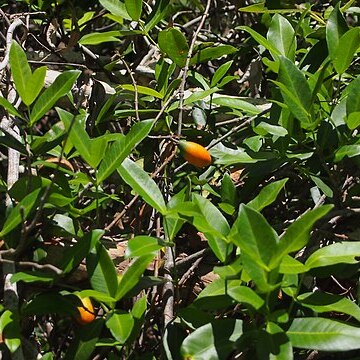A climbing vine or twiner. It grows up to 3 to 8 m tall. The leaves are simple and 3-16 cm long and 0.5-6 cm wide. The leaves are darker green on top and paler beneath. The broken leaves and twigs drip milky sap. The branched flower stalk occurs in the angles between leaves and stem in the upper leaves. The flowers are 0.4-0.7 cm across. They are pale yellow. They have a strong smell. The fruit are 4-15 cm long and 2-4 cm wide. They hang singly or in bunches in the axils of leaves. The fruit are green but then turn yellow then orange. The fruit often have several colours. The fruit have many seeds which are 5-7 mm long. The pulp around the seed is edible. It is green in colour. The fruit are also eaten by cockatoos and cassowaries.
Liane. Leaves with petiole 1.5–3 mm long; lamina lanceolate-ovate, elliptic or obovate, 3–16 cm long, 0.5–6 cm wide, cuneate, acute, mucronate or rounded; secondary veins 11–13 each side of midrib; tertiary venation obscure. Inflorescence of much-branched dichasial panicles to 2.5 cm long. Flowers 4.5–7 mm long, 4–7 mm diam.; pedicels 3–7 mm long. Sepals ovate, 0.6–1 mm long. Corolla cream-yellow; tube 3.5–5.5 mm long, 0.8–1.3 mm wide; lobes obovate, 3–3.2 mm long, 1.5–2 mm wide. Corona lobes 5, 0.8–1.1 mm long, bilobed, adnate to base of corolla lobes. Fruit obloid-ovoid, 4–15 cm long, 1.5–4 cm diam., orange-red when ripe.

